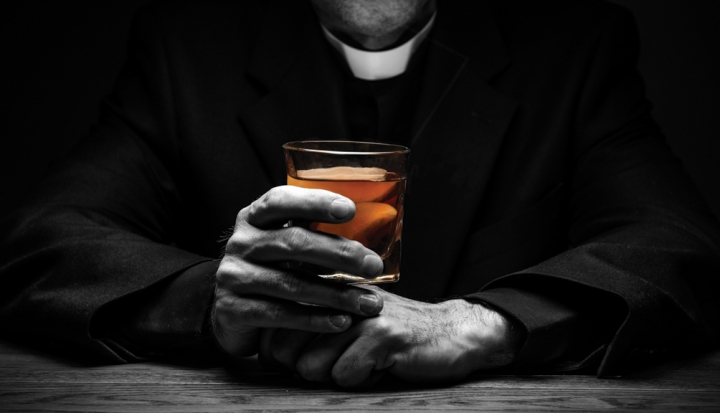A priest’s alcoholism becomes the parish’s affliction, too.
Every week or so, Father Ray toted a suitcase past the rectory offices. “Dry cleaning,” he’d say.
“Liquor bottles,” feared both the pastor and Mary Catherine Meek, who worked in the suburban Chicago parish. People caught whiffs of alcohol on Father Ray (not his real name) at Mass. He had undergone treatment for alcoholism before this assignment.
Confronted by the pastor, Father Ray denied relapsing. The pastor expressed his concerns to the diocese.
“Then Father Ray had it out for the pastor because he was getting him in trouble,” Meek says. “Father Ray took it upon himself to go out and visit the sick so that he could say, ‘Look, I wouldn’t be doing this if I were drinking.’ He had the parish secretaries bedazzled with his charm and easygoing humor. He would sit chitchatting for an hour and actually interrupt their work, but he was forming a protective shield around himself.”
Unresolved tensions mounted, and the diocese reassigned Father Ray. He was to move a week after Meek left for a retreat. She phoned the parish on the first day of the retreat and heard Father Ray was sick. She suggested someone take soup to him. She called the next day. No one had seen him.
“I said, ‘You guys all live together, you need to check on him.’ ”
A priest found Father Ray lifeless in his room, which was strewn with bottles and soiled with vomit.
The strife didn’t end there. Days afterward, the pastor’s teenage niece answered a phone call in the parish office: “We hope the pastor is happy now that he has killed Father Ray!” the caller said.
“Her eyes got so wide. That was awful for her,” Meek says. “But that is that alcoholic personality. Father Ray was very strong in making this divisive.”
Suffering a crisis in confidence, the pastor sought a demotion. Meek left her post.
“Being right didn’t make it feel any better,” Meek says, and it still doesn’t, 20 years later. “For whatever reason, the legacy of Father Ray went on even though he was untruthful. You know what they say with children—they often prefer the alcoholic parent because the other parent has to be the disciplinarian. I saw some of that, too.”
So has Father William Stenzel, a Chicago archdiocesan priest. In 35 years of ministry surrounding alcoholism, he has observed that when an addicted priest hits bottom, a parish often does, too. Key leaders and devoted parishioners adopt the same unhealthy coping mechanisms of a family with an alcoholic parent—infighting and codependency among themselves.
When the priest gets sober, issues can arise. The problem is that most literature on alcoholism in the workplace assumes the employee, not the boss, is suffering from the disease.
That’s why Stenzel and Guest House, the addiction treatment center for Catholic clergy and religious with facilities in Rochester, Minnesota and Lake Orion, Michigan, are crafting a healing program targeted to the parish and staff.
“It’s a hard sell for a parish to get its hands around the fact that it’s sick, too,” Stenzel says. “We’re looking at how we can offer more assistance to a parish when a priest has gone into treatment for alcoholism and other addictions. Part of that is based on the need for the priest to return to a healthy situation, as opposed to one where anger hasn’t been dealt with or enabling behaviors haven’t been adjusted.”
A priest’s alcoholism can elude detection longer than in other vocations, because of celibacy and frequent moves. Plus, drinking is endemic in church culture, summed up by the adage, “Where four Catholics are gathered, you’ll always find a fifth.”
In any setting, early warnings are often missed. “A symptom is high tolerance,” Stenzel says. “Early-stage alcoholism is often a guy who can drink everyone under the table and drive his friends home. It’s the reason, for example, why a high percentage of women who grew up with an alcoholic father resolve never to marry a man like that, and they end up married to an alcoholic. They see their father in middle-stage alcoholism who has lost that high tolerance and is drunk after a few beers. So they’re attracted to men who can drink a lot without it affecting them. The disease shows itself differently at different stages.”
Guest House says the rate of diagnosed alcoholism among priests mirrors that of the general population—about 10 to 12 percent. But many suspect that priests have a significantly higher rate.
“One of the hallmarks of priests in this age is they don’t drink in public,” says Jeff Henrich, executive director of men’s treatment for Guest House, which treats about 100 men a year for alcoholism—a stable number for the past decade despite a shrinking pool of priests.
They drink alone in the rectory after the day’s responsibilities are done, Henrich says. Sometimes an addiction surfaces only if someone calls after hours with an emergency and a priest slurs into the phone.
If this healing program can help in such challenging circumstances, Stenzel hopes it can help secular workplaces, too.
Red flags
The average age of first treatment for priests at Guest House is 60. “They don’t have that kind of addiction like the young people who are getting into bar fights,” Henrich says. “They have likely been doing what looked like heavy social drinking for 30 or 40 years. It’s only after age 55 or so, as their bodies start to close down but they continue to drink as much or start drinking more, that we’d see anything that looked like the shakes or withdrawal.”
Most red flags are subtler: swinging moods, missing meetings, arriving late for Mass, delegating governance, mismanaging funds.
Older priests often mask alcoholism as other health problems, saying, for example, “I can’t say Mass today. These new medications I’m on really have me not feeling well. The doctors are going to do more tests.”
“People respond really empathically to that,” Henrich says. “The alcoholic is really a master at getting people to look at something other than what’s really going on. They’re like a magician in that sense. It’s not malicious. It’s self-preservation.”
The disease at times wears a disarming disguise, as with one gregarious young priest arriving in a small-town parish in the Pacific Northwest. A jogger and a joker, he attended civic festivals. He connected with youth groups and Hispanic families, who were amused by his efforts to speak their language. He collected beer bottles and shot glasses. Parish registry grew from around 400 to 600 during his tenure.
Often complaining he was too tired to say weekday Mass, the priest returned from one of his weekend trips to a nearby city, ostensibly to help with Marriage Encounter, with his car smashed. A hit-and-run, he explained. Court summonses came. He took care of it, he assured people. More legal notices arrived.
The chair of the pastoral council, Larry Smith (a pseudonym), consulted a friend in law enforcement, who said the priest had used a false ID in an encounter with police. “I didn’t want it to be a witch hunt, but we were wondering, just what are we dealing with?” he says.
Smith met with the bishop, who asked to be alerted to the priest’s next weekend away.
Soon after, Smith was informed that the bishop’s investigation found the priest was cited for driving under the influence of alcohol, that he frequented gay bars in the city and accessed pornography—not involving children—on the church computers.
That Sunday, the priest announced at Mass that he was leaving. Shocked parishioners grieved and pointed fingers, unaware of all the circumstances of the priest’s double life or the squalor found in the rectory. After receiving treatment in Maryland, the man left the priesthood.
“There are still people to this day that think he was forced out by the bishop,” says Smith, whose term as chair has since ended. “We went through three pastors in the 11 months afterward.”
Studies show one compulsive or addictive behavior often begets another. “Some people compensate for one, replacing it with another—they stop drinking and start eating,” Henrich says. Gambling and shopping also are common. “And no matter who you are, if you have an addiction diagnosis, there’s about a 60 percent chance you’ll also have a mental health diagnosis at some point, such as depression or anxiety.”
Being an alcoholic does not statistically increase one’s chances of being a sexual predator, Henrich says.
Unwitting enablers
Less awed by their priests these days, parishioners are quicker to call the vicar’s office or the chancery if they suspect a drinking problem. Documenting observations with dates and names of witnesses adds gravitas to the complaint, says Erik Vagenius, a member of the National Catholic Council on Addictions who started the Substance Addiction Ministry program in Palm Beach, Florida.
“That sometimes scares people away,” Vagenius says. “But unless you’ve collected data, there can be a reticence to support the intervention. I’ve gone out to do an intervention, and the person who had the ability to make the person go to treatment—the ordinary, the power broker—decided, ‘No, I’m not going to make the person go.’ ”
Meanwhile, key parish staff often assume unhealthy roles associated with children of alcoholics—hero and scapegoat among them.
“There may be those who want to rescue and save Father,” Stenzel says. “There may be others who take an angry stance. Some enable the sickness to progress. An employee with ‘hero’ symptoms of codependency would feel obliged to stay late and assist others rather than go home on time having met all of his or her responsibilities for the day.”
Stenzel coaches parish staff to get comfortable with the phrase, “I’m not on for that.”
“The more people cover for the alcoholic, the more easily he can stay in his distorted belief system that there’s no problem. It’s what happens in a family, where a husband calls the wife’s boss saying she can’t come to work, or the husband comes home and knocks over furniture and the wife restores order before morning.”
Confronting dishonesty
Richard Guerin, award-winning principal at St. Bede the Venerable School on the southwest side of Chicago, read and reread Melody Beattie’s Codependent No More (Hazelden) after allegations emerged about the church’s pastor, Father Brian Lisowski.
Lisowski had been sober for years when he came to St. Bede, recalls Guerin. “When he was on, he was as good a priest as I ever worked with, very caring, a very high energy level,” Guerin says.
Oddly, Lisowski began arriving at work at 6 in the morning. In a more typical warning sign, he’d erupt about oversights such as kids leaving the lights on in the gym.
“I found myself spending a lot of my time protecting my faculty, parents, and groups from Brian’s temper,” says Guerin, who became his proxy at meetings and ran wedding rehearsals when Lisowski said he had a conflict, often citing a gathering with his family in the area.
Guerin asked Lisowski if he was drinking. He said he wasn’t.
One day in 2004, the priest walked into Guerin’s office and told him, “I’ve got some trouble.” Police had stopped him in the company of a woman believed to be a prostitute.
“I asked, ‘Were you drinking?’ He said no. I knew he had been because I talked to the police officer,” Guerin says.
“I told Father Brian, ‘If you don’t leave, I’m leaving.’ ”
Thanking Guerin, Lisowski said he would resign.
Immediately, the money in the weekly collections surged, triggering an investigation. Charged with money laundering, Lisowski paid more than $1.2 million in restitution.
The bishop recommended counseling for key staff. Guerin went bitterly.
“The counselor asked me how I really felt. I said, more hurt that someone with all this potential hurt a parish that I had given my life to, to such an extent. It brought out so much anger. We had just a terrible time afterward. It was hard to explain to the children. Some people never came back to the church and used that as the reason, or it was the reason.”
Until his retirement last summer after 37 years at the school, Guerin continued to remind himself, “I’m not on for that.”
Challenges in recovery
Stenzel addresses wounds in his healing sessions. “I’m willing to bet that most of the time when you had a staff meeting there was a fight and you went home mad at somebody,” he told one parish group.
The principal of that parish school raised her hand and said, “They all went home mad at me. I never knew why until this morning. Father never said no to me. Whatever I wanted, there was always money. He always said no to them.”
She disclosed that her father also had been an alcoholic and had cast her in a similar role.
“I know how to work with an alcoholic,” she said. “I’m terrified of Father becoming sober because I don’t know if I’ll know how to work with him.”
The staff committed to attend Al-Anon while the pastor was in treatment, to overcome dysfunctional dynamics.
About 65 percent of priests who go for treatment return to the same parish, partly because making amends can strengthen the recovery. More often than not, when they disclose where they’ve been, the parish responds with a standing ovation.
Once the applause stops, however, some lay leaders resent relinquishing status they gained when their priest was incapacitated.
“Often by the time a pastor goes for treatment, there’s nothing left on his desk except the junk mail,” Stenzel says. “It’s like the oldest son who takes over for the father who no longer can take the kids to Little League. There’s going to be some resistance to dad now being a functioning parent. It can be an overwhelming task to come in and put leadership in place when a parish has been devoid of it. The new sober guy is more of a demon than the drunken pastor.”
Get your own help
A priest who has completed treatment often plunges into work to relieve guilt.
“But often alcoholism is associated with stress in the work environment,” says Bob Martin, retired community liaison and senior counselor at Guest House. Martin often would apprise parish leaders of the priest’s need to off-load some duties and to treat support group meetings as sacred.
Renegotiating parish roles helps everyone’s recovery, says Jim Lundholm-Eades, director of services and planning for the National Leadership Roundtable on Church Management.
“When there’s clear role definition, you see problems arise quicker; you catch them sooner,” he says.
After a priest receives treatment, some leaders think, “You learned how to behave, now go behave,” Stenzel says. Staff who interact closely with the priest should attend Al-Anon or seek other education. “Otherwise, you’re dangerous to him in the same way you would be if he’s paraplegic and you helped him into a car without finding out the correct technique,” Stenzel says.
As time passes, alcoholics can abandon AA meetings. Or they are reassigned, losing their support system.
“Relapse is where a lot of dioceses might fall down,” Stenzel says. “No one monitors, and now we have another crisis on our hands.”
Recovery requires follow-up, accountability, and some selfishness, both for the priest and parish leaders.
“We don’t want him to feel he has 10 amateur detectives following him around,” Henrich says. “But Father should be able to explain his actions and give everyone permission to say, ‘I see this and I don’t understand.’ They should identify who they go to if Father gets angry when they ask him or if he won’t answer.”
A team approach to recovery rewards everyone.“I’m not recommending every priest become an alcoholic,” Lundholm-Eades says. “But when someone goes to the bottom and works his way up again, my experience is he’s an extraordinary priest when he does. He gains compassion. He understands people and the human condition in a whole different way.”
Interested in reading more? Here are two web-exclusive sidebars that accompany this article: Identifying alcoholism in the workplace and How to stage an intervention with an alcoholic.
This article appeared in the June 2013 issue of U.S. Catholic (Vol. 78, No. 6, pages 23-27).
Image: Tom Wright














Add comment